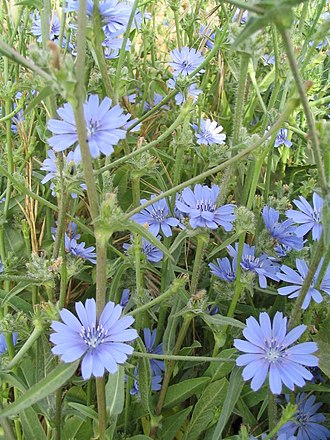Cichorium pumilum
Cichorium pumilum is a species of flowering plant in the Asteraceae family, commonly known as the dwarf chicory. This perennial herb is native to parts of Europe, North Africa, and the Middle East, where it thrives in a variety of habitats, including grasslands, roadsides, and fields. The plant is notable for its small stature, rarely exceeding heights of 30 cm, and its bright blue flowers, which bloom from late spring to early autumn.
Description
Cichorium pumilum exhibits a rosette of basal leaves from which emerges a slender, branching stem. The leaves are lanceolate to oblong, with a slightly toothed margin. The plant's most distinctive feature is its bright blue, daisy-like flowers, each composed of numerous small florets. These flowers are borne singly on the stem tips, attracting a variety of pollinators, including bees and butterflies. The fruit is an achene, equipped with a pappus that aids in wind dispersal.
Distribution and Habitat
Originally native to the Mediterranean region, the distribution of Cichorium pumilum has expanded to encompass parts of Western Asia and Europe. It prefers open, sunny locations and is commonly found in meadows, along roadsides, and in agricultural fields. The plant is adapted to a range of soil types but thrives in well-drained, moderately fertile soils.
Ecology
Cichorium pumilum plays a role in the ecosystem as a source of nectar and pollen for various insects. Its flowers are particularly attractive to bees, which are the primary pollinators. The plant's ability to grow in disturbed soils also makes it an important pioneer species, contributing to soil stabilization and the regeneration of plant communities.
Uses
While not as widely cultivated as its relatives, the common chicory (Cichorium intybus) and endive (Cichorium endivia), Cichorium pumilum has been used in traditional medicine and as a wild foraged food. The leaves can be eaten raw or cooked, offering a slightly bitter flavor reminiscent of other chicory species. In traditional medicine, various parts of the plant have been used to treat ailments such as digestive issues and liver problems.
Conservation
Cichorium pumilum is not currently listed as a species of conservation concern. However, like many wild plants, it faces threats from habitat loss, agricultural intensification, and urbanization. Conservation efforts focused on preserving natural habitats and promoting biodiversity can help ensure the survival of this and other native plant species.
Transform your life with W8MD's budget GLP-1 injections from $125.
W8MD offers a medical weight loss program to lose weight in Philadelphia. Our physician-supervised medical weight loss provides:
- Most insurances accepted or discounted self-pay rates. We will obtain insurance prior authorizations if needed.
- Generic GLP1 weight loss injections from $125 for the starting dose.
- Also offer prescription weight loss medications including Phentermine, Qsymia, Diethylpropion, Contrave etc.
NYC weight loss doctor appointments
Start your NYC weight loss journey today at our NYC medical weight loss and Philadelphia medical weight loss clinics.
- Call 718-946-5500 to lose weight in NYC or for medical weight loss in Philadelphia 215-676-2334.
- Tags:NYC medical weight loss, Philadelphia lose weight Zepbound NYC, Budget GLP1 weight loss injections, Wegovy Philadelphia, Wegovy NYC, Philadelphia medical weight loss, Brookly weight loss and Wegovy NYC
|
WikiMD's Wellness Encyclopedia |
| Let Food Be Thy Medicine Medicine Thy Food - Hippocrates |
Medical Disclaimer: WikiMD is not a substitute for professional medical advice. The information on WikiMD is provided as an information resource only, may be incorrect, outdated or misleading, and is not to be used or relied on for any diagnostic or treatment purposes. Please consult your health care provider before making any healthcare decisions or for guidance about a specific medical condition. WikiMD expressly disclaims responsibility, and shall have no liability, for any damages, loss, injury, or liability whatsoever suffered as a result of your reliance on the information contained in this site. By visiting this site you agree to the foregoing terms and conditions, which may from time to time be changed or supplemented by WikiMD. If you do not agree to the foregoing terms and conditions, you should not enter or use this site. See full disclaimer.
Credits:Most images are courtesy of Wikimedia commons, and templates, categories Wikipedia, licensed under CC BY SA or similar.
Contributors: Prab R. Tumpati, MD

